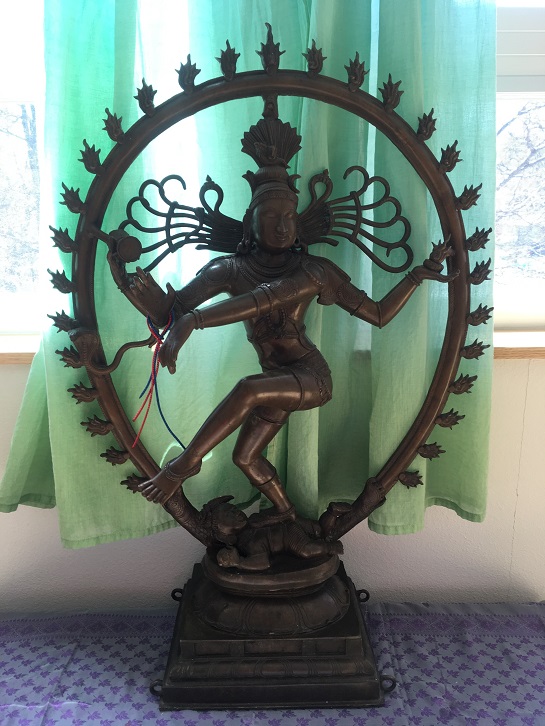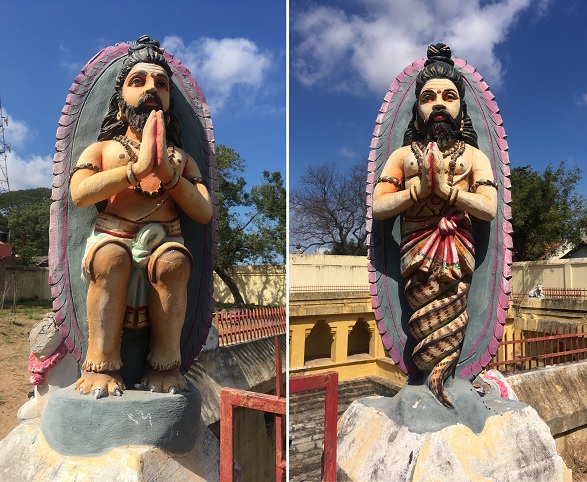One of the most famous and important core myths from India is that of the Churning of the Ocean. Its teachings are relevant not only to the practice of yoga, but also to life in general, and how to live your yoga. As with many myths in the tradition, there are different versions from different sources, so we will be dropping into the middle and extracting an abbreviated version of this story known as the Samudra Manthana or Sāgara Manthana. Samudra and sāgara are both words for the ocean, and manthana means “churning.”
Once upon a time, the devas and asuras—the gods and anti-gods (demons)—who usually were at odds with each other—realized they needed to work together to obtain the nectar of immortality, which resided in the ocean. To obtain the nectar, they had to churn the ocean to bring it forth. To do so, they upended a mountain to use as the churning stick. They stuck its top into the ocean with a great tortoise as a base. Around that, they wrapped the snake named Vāsuki to use as a rope.
They churned and churned, yet the nectar was not emerging, and they became a little discouraged. Viṣṇu was summoned to help, and he gave them a pep talk that re-energized them to continue churning. Finally, a great variety of treasures began to emerge from the ocean, including the crescent moon, the goddess Śrī (or Lakṣmī), a great gem, and an albino elephant with four tusks. As these things emerged from the ocean, they were claimed and distributed in various ways to both the devas and the asuras.
As the gods and demons continued to churn, what began to emerge was a viscous, deep-blue, radioactive-like substance that could paralyze the world with its vapors. This was a poison called kālakūṭa or halāhala. As in many of these stories, when things got difficult, Śiva was called upon to deal with the problem. Some accounts say he drank the poison; others say he put his finger in it and absorbed it that way. In either case, so that the world would not be obliterated by the poisonous substance, Śiva held it in his throat, where it was transmuted. The poison turned his throat blue, and this is how Śiva got his name Nīlakaṇṭha. Nīla means “blue,” and kaṇṭha means “throat.” Once the poison was dispensed with, the churning resumed, and several other things emerged from the ocean, including a wish-fulfilling cow. Finally, the physician of the gods emerged, holding a pot in which the nectar was held.
One way to interpret the overall story is as a metaphor for the practice of meditation. The ocean is consciousness, which is churned as we practice. Often we practice and practice and nothing seems to be happening, and we might even want to stop. Hopefully we continue, perhaps with some encouragement from a teacher or someone else who is our Viṣṇu. There may also be challenges and “poison” that arise. We, as Śiva, must be able to hold and transmute that poison. It is part of the process. In the story, it is only after the poison has been emitted that the nectar emerges.
When we do yoga, whether the physical āsana practice or meditation, there’s a naturally occurring cleaning-out of all that obstructs us: the saṃskāras, all the old crud from previous actions. On the physical level, āsana can take us to the sticky places, physically or psychologically— or both. When moving in āsana practice, we come up against physical limitations. These can be patterns in the body established from lack of movement, from holding ourselves in particular ways, from old injuries, or for any number of reasons. Working through these limitations can be challenging and even painful at times, yet hopefully we eventually receive the joy of more ease in the body. In āsana practice, we may also have to deal with old, reactive psychological patterns.
Likewise, when the mind is moved inwardly in meditation practice, we encounter whatever blocks us. The muck is invariably stirred up. When meditating, we might begin to feel agitated physically, emotionally, or mentally. Or, we might simply start having thoughts. The thoughts or agitation that arise during meditation are a byproduct of this natural cleansing of awareness when moving from the surface to the depths to contact the deepest layers of our self, toward a greater awareness.
As we move along the path of yoga, doing our practices, at times there will be delight/ānanda, health, and healing. But remember, the nectar/amṛta emerges only after the poison has been dealt with. And truthfully, sometimes what we think is poison is actually nectar, once it is held and transmuted. Finally, I love that one of the things that emerges from the act of churning the ocean is the wish-fulfilling cow. As my practice has progressed, it is my experience that my wishes—my desires and intentions/saṃkalpa- become more auspicious and aligned with the Highest.
REFLECT AND EXPLORE
– Contemplate any aspect of the Churning of the Ocean story that speaks to you.
– How are you every character in this story? For example, consider the role of Viṣṇu on the path of yoga and life. Who has been your Viṣṇu? How have you been Viṣṇu to others?
– What treasures have emerged from your practice(s)? Consider the practices of āsana, meditation, and any other practices you do.
– How have you experienced poison arising in your practice, and how have you handled it?
– How have you eventually noticed more healing or joy after a “poisonous” experience?








